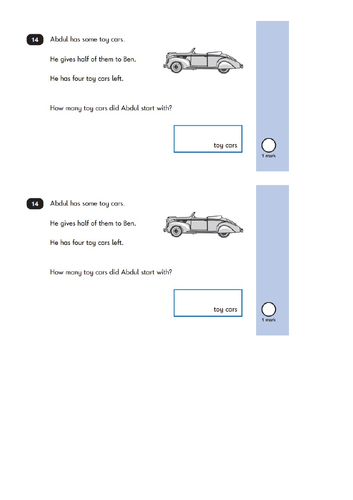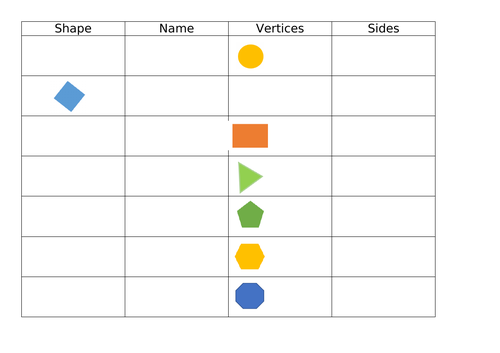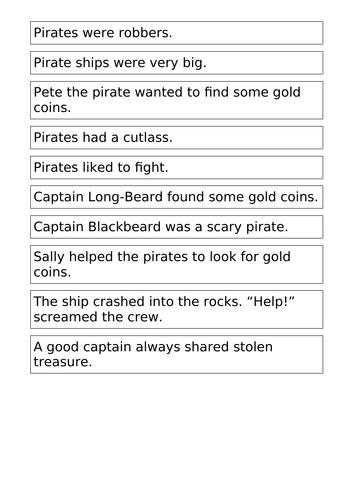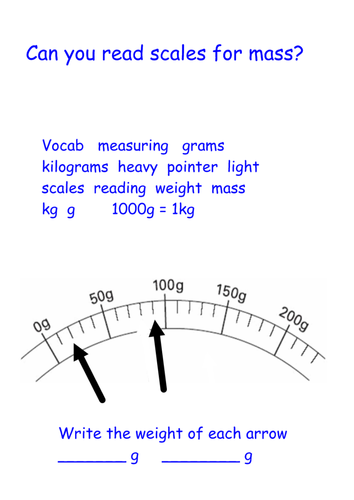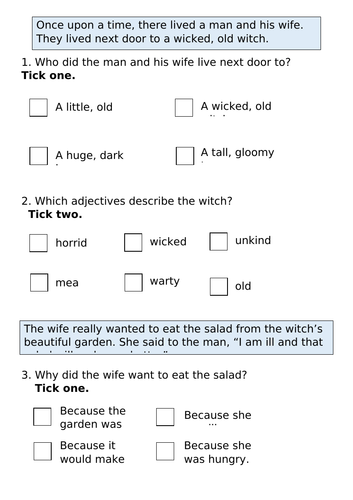
14Uploads
47k+Views
187k+Downloads
All resources

Selecting Money - Making amounts using coins and notes Year 2
I made this ActivInspire flipchart to help my pupils make different amounts using coins and notes.
It starts off very simply making 6p, with the full range of coins available to select from. I talked about how we can make 6p using different coins, e.g. with a 5p and a 1p, or 1p + 1p + 1p + 1p + 1p + 1p or 2p + 2p + 2p. It gradually builds up to making larger amounts using pounds and pence. Eventually, it ends up asking for notes as well as pounds and coins.
On an interactive whiteboard, you can drag the coins and the notes from the display into the box to make each amount.
I found it extremely useful. I also linked it with a document from Twinkl, which showed each coin and note and its value along with Numicon so that pupils had a solid representation of the value of each coin and note.

Year 2 SATS - Arithmetic - find halves and quarters of numbers
I have been through the SATs arithmetic papers for the last few years and made a booklet of finding halves of numbers and finding quarters of numbers. I taught these on separate days so they are two separate documents. I used them purely for extension work after children found halves and quarters of numbers, to get them used to the format of the arithmetic papers.
I also included a couple of questions from the reasoning and problem solving papers.
Get your children SATs ready!

2d Shapes - Count sides and vertices Year 2
Just a simple worksheet for counting sides and vertices on 2d shapes.
PDF and original word document included.

Year 2 Find Half of Shapes
Lesson plan, ActivInspire flipchart using part-whole models to introduce the idea of fractions as part of a whole, differentiated activities, extension work and plenary.
I hope they save somebody some time.
Geared towards a Year 2 class preparing for SATs.
Please review if you download. Thank you!

Telling the time - 'Building a clock'
My class were really struggling to tell the time, so I made this powerpoint presentation which ‘builds a clock’ from scratch. It starts off as just a blank circle, which is then divided into half (referencing past fractions of shapes work). We talked about when the minute hand is half way around, we know it is half past, or 30 minutes past (half of 60 minutes - building on prior learning of 60 minutes in an hour).
The clock is then divided into quarters - so we know when it is quarter past and quarter to.
After this the lines disappear and the inside numbers appear on the clock, one at a time. We talked about how these are the hours - not the minutes. This is how we know which hour of the day it is, whether it is 8 o’clock, 5 o’clock etc.
Then, the ‘minutes’ appear around the outside of the clock. To support their understanding of minutes, I used only the minute hand at first, and we learnt how many minutes past each point on the clock is. I continued this all the way around the clock, rather than confusing them with ‘past’ and ‘to’. For example, we practised saying “40 minutes past” and “55 minutes past”.
After this, the children built their own clock from scratch. They had an outline of a clock with coloured dots for each minute. I colour coded the dots for each hour. When they had stuck the hours on, they placed the ‘minutes past’ labels around the outside. After this, they worked in pairs to move their minute hand around the clock to find the ‘minutes past’ that I called out. For example, if I called out “10 minutes past”, they moved their minute hand to the correct place on their clock. We stuck the minute hand on using split pins so they swivel easily. Please see attached photo for an example of the clock - this is an idea I saw on pinterest, so it is not my own but I found it extremely useful.
This really helped children to understand the role of the minute hand on a clock. Our next step is to add an hour hand onto the clock and begin to find “40 minutes past 5”.
The day before the clock building lesson, we spent our Maths lesson practising counting in 5s and talking about how many seconds in 1 minute, how many minutes in 1 hour etc. We did the traditional “How many jumps can you do in 1 second? How many jumps can you do in 1 minute? How many do you think you could do in one hour?” etc.
I hope that you find this as useful as I did. Please feel free to ask any questions, and I’d really appreciate a review if you download.

Pirates - Fiction or Non-Fiction? Sorting activity - Year 2
Aimed at a Year 2 class. Children can either cut up the sentences and organise them into a grid or draw a grid of their own and write the sentences into their books. Identify which sentence types are Fiction and which are Non-Fiction. Based on pirates; our topic.

Year 2 - Money Fruit Shop - Find the total differentiated
I’d like to credit original author ruthbentham for this resource (link: https://www.tes.com/teaching-resource/money-fruit-shop-find-the-total-differentiated-6229177
I adapted the resource for the needs of my class and thought I would re-share.
My children will be selecting two (or three to challenge the more able) fruits and sticking them in their books. Then they will find the total by either using Numicon (SEN) or by drawing the tens and ones.
SEN - Items are below ten. Children will select 2 fruits to add together and will calculate the total using Numicon.
LA - Items are ‘teens’ numbers. Children will select 2 fruits to add together and will calculate the total by drawing the tens and ones.
MA - Higher prices for items used. Children will select 2 (or 3) fruits to add together and will calculate the total by drawing the tens and ones.
HA - Higher prices for items used. Children will select 2 (or 3) fruits to add together and the total will be above £1. They will convert p to £ to find the total.

Differentiated Goldilocks and the Three Bears SATS Style questions Year 2
I made these differentiated SATs style questions for whole class reading in Year 2. They practise some of the skills required for the year 2 SATs reading paper.
I have uploaded the word documents which are fully editable, as well as the PDFs which retain our font.
I hope that you find them useful.

Burglar Bill Year 2 SATs style questions differentiated
I made these differentiated SATs style questions for whole class reading in Year 2. They are based on the book, Burglar Bill, which we were also using in English. They practise some of the skills required for the year 2 SATs reading paper.
I have uploaded the word documents which are fully editable, as well as the PDFs which retain our font.
I hope that you find them useful.

Safer Internet Day 2019 Powerpoint for primary school parents' meeting
Please note that the content of this Powerpoint Presentation has been snipped from various resources from the safer internet centre’s uploads for parents and carers for Safer Internet Day 2019. Please see link below for these resources. These are freely available on the Safer Internet UK website and I have included the link to them below. I have just taken snips of these resources to create an easy powerpoint presentation that can be used to engage parents with Safer Internet Day 2019.
I have created a powerpoint that I will share with parents in a meeting surrounding the theme of this years’ safer internet day theme of ‘Together for a Better Internet’. I will be downloading parent and carer resources from the UK Safer Internet website as handouts (please see link) and this powerpoint will talk through how our school will be participating in Safer Internet Day 2019 as well as discuss the resources available to parents for enabling them to further support key messages and learning at home.
Here is where you will find all of the resources for carers and parents:
Click Here

Measuring Mass (weight) in grams - reading scales Year 2
I searched for hours to find sets of scales where children read the scales and record the weight in grams. It was a surprisingly difficult task! Everything was far too hard for a first lesson in this after a practical activity.
Luckily I had made a few worksheets from a few years ago by screenshotting some IWB games. I hope that you find them useful, I was certainly very relieved to find them.
LA were challenged further by weighing objects of their own choice - using balance scales and 1g weights and then a set of kitchen scales.
MA were challenged further by using the Twinkl challenge cards found here: https://www.twinkl.co.uk/resource/au-n-599-year-2-mass-challenge-cards
And HA were challenged further by using the Twinkl activity cards found here:
https://www.twinkl.co.uk/resource/year-2-diving-into-mastery-measure-mass-g-activity-cards-t-n-2546876

Superworm SATS style questions
I have made these SATs style questions based on the ‘Superworm’ story by Julia Donaldson.
They practise some of those tricky skills such as ticking boxes, sequencing with numbers, true and false statements etc. I will be using these during whole class reading and I plan to use one activity type per day.
I have uploaded the files in PDF format to retain the font and I have also included the original word documents in case you wish to edit them.
Please could I ask that you review my resources to tell me what you think?
Thank you!

Year 2 Missing number 2 digit
I couldn’t find any resources that I liked for missing number problems, so I created these resources.
It’s a sheet of missing number calculations with a squared space for working out calculations.
My pupils really struggled with this concept so I really broke it down for them before they tackled these:
Lesson 1 - missing number at the beginning (1 digit numbers) - INVERSE
Lesson 2 - missing number at the beginning (2 digit numbers) - INVERSE
Lesson 3 - missing number in the middle (1 digit numbers) - SUBTRACTION
Lesson 4 - missing number in the middle (2 digit numbers) - SUBTRACTION

Rapunzel SATs style Questions for Year 2 - very simple!
Here are 5 sheets of Rapunzel themed questions. I have been using them with my Year 2 class during whole class reading to practise finding information within a text to answer questions. The questions include a range of tick boxes, ‘find and copy’ questions as well as general retrieval questions. They are very simple for this point in the year, as this is the first time my class will have done anything like this. Each lesson, we focus on only 4 questions and focus on a discussion about how to find answers in a text. I usually complete the first two questions as a class, and then children complete the next two questions independently.
I have included the PDF to retain the font, as well as original word documents.


